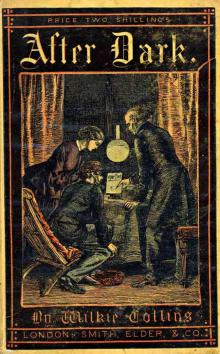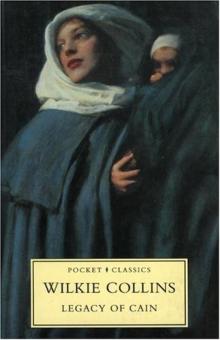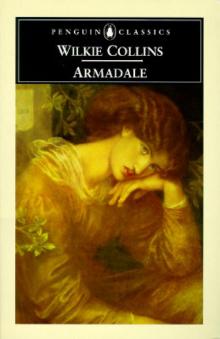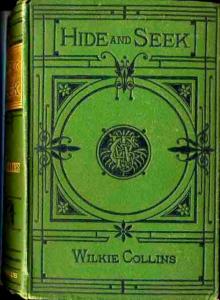- Home
- Wilkie Collins
Woman in White (Barnes & Noble Classics Series) Page 3
Woman in White (Barnes & Noble Classics Series) Read online
Page 3
The widespread public frenzy over The Woman in White at the time of its serial publication produced immediate effects, almost post-modern in their marketing synergy: the strong sales of Woman in White tie-ins, such as perfume, cloaks and bonnets; the composition of waltzes and other dances inspired by the novel; and the sudden popularity of the name Walter for newborn sons and of Fosco for pets (particularly cats). Readers cast wagers on the outcome of various plot twists and what Sir Percival’s terrible secret could be. Immediately following the end of its serial run, the novel was published in a three-volume edition in Britain and the United States. Its numerous positive reviews praised the novel as being “extremely clever,” “the greatest success in sensation writing,” and “a most striking and original effort.” Collins’s huge audience agreed with these assessments.
Yet many of his contemporary critics faulted Collins for numerous things, including an overabundance of unnecessary details and what they saw as his lack of characterization: “Remove all that there is of rather improbable incident in The Woman in White, and you might burn what remains without depriving the world of any imaginative creation, any delineation of character, or portrait of human nature worth preserving,” complained the Saturday Review (August 25, 1860). Even the very premise of his self-proclaimed new form of storytelling was challenged. Collins boasted in his preface that he had invented the strategy of employing multiple narrators, although the practice of telling a story through various characters’ pens had been established more than a century earlier in the epistolary tradition of novels built upon a series of letters from different protagonists. Some reviewers objected to Collins’s analogy of his fictional figures’ giving their evidence as though they were witnesses at a trial. The Saturday Review commentator wrote, “They are staring listlessly and vacantly, like witnesses who are waiting to be called before the court, and have nothing to do until their turn arrives.” This somewhat rigid structural method was also found to be “unnatural” and “an affectation.” As some of the more careful critics have remarked over the years, Collins’s technique can sometimes produce an ironic counterpoint to his characters’ defining qualities. The selfish, supersensitive hypochondriac Frederick Fairlie, for example (whose effete sensibilities mark him as a useless member of the aristocracy—clearly not a man of resolution), cannot be roused to make the least bit of physical or mental effort to save his niece, yet we are to believe that he would write a lengthy narrative of his involvement at Walter’s urging?
Other early negative criticism of The Woman in White focused on Collins not as a great novelist but as a mere “constructor,” if a very talented one, of intricate plots; as such he is a good storyteller, but, as the Saturday Review noted: “Mechanical talent is what every great artist ought to possess. Mechanical talent, however, is not enough to entitle a man to rank as a great artist.” And, “Our curiosity once satisfied, the charm is gone.... We should prefer hiring [his books] out as we do a Chinese conjurer—for the night. As soon as we have found out the secret of his tricks, and admired the clever way in which he does them, we send him home again.” Undoubtedly, some of the critical vitriol aimed at Collins stemmed from his request that reviewers not discuss the plot. When pressured not to remark upon the novel’s main point of satisfaction, the critics understandably balked. From The Times (October 30, 1860): “Has he so little faith in his own powers as to imagine that if the secret is once out his novel will lose its fascination, and have nothing else to recommend it to the reader? ... If we are not to touch the story, what else is there to touch?” Collins did not want his critics to let the cat out of the bag, yet in his labyrinthine construction they found themselves with “about a hundred cats contained in a hundred bags, all screaming and mewing to be let out.”
A new one-volume edition of The Woman in White appeared in 1861; this slightly revised version addresses criticisms of the plot’s faulty timeline (which Collins alludes to mysteriously in the preface as “certain technical errors”) that had originally appeared in the Times review. The anonymous author proves that Collins is off by two weeks in his chronology, incorrectly fixing the date upon which the novel’s main question hinges, that at which Laura leaves Blackwater Park, her husband’s estate. The problems with the date, crowed The Times, “render the last volume a mockery, a delusion, and a snare; and all the incidents in it are not merely improbable—they are also absolutely impossible.” Also, in order to create tension surrounding the accuracy of this date, critics noted, Collins had to “invent ignorance which could not exist,” in the Blackwater Park housekeeper, Mrs. Michelson, who inexplicably cannot remember the date in question even though it coincided with the termination of her own employment. “The novel will not bear a very close inspection. It is rather to be devoured whole, as a boa constrictor bolts a rabbit, than to be criticized in detail,” The Times jeered. As the Saturday Review critic noted of some crucial legal misjudgments the characters make, “If Mr. Collins is not unjustifiably unintelligible, the titled villains of the story must have been unjustifiably stupid.”
In an article on sensation fiction for Blackwood’s Magazine (May 1862), the prolific popular novelist Margaret Oliphant (author of one sensation novel, Salem Chapel, 1863, and herself not overmuch a Collins fan) bemoaned the particular stresses, the “violent stimulant,” of weekly serial publication—as opposed to the heretofore more typical monthly installment, in which her own more respectable novels appeared. Such pressure to produce stimulating cliffhangers week after week, in a “frequent recurrence of piquant situation and startling incident,” she wrote, would sow the seeds of corruption in English readers and ultimately bring about the decay of the national literature (the English literary establishment at the time criticized French novels for their reliance on scandalous scenes to maintain reader interest, a practice judged to be immoral). Oliphant also feared that countless less talented imitators would soon spring up and adopt Collins’s style. Many less skilled writers did attempt to imitate The Woman in White’s narrative strategies and plot devices, with varying degrees of success. Sensation novelists with talent, however, such as Collins’s contemporary Mary Elizabeth Braddon, also placed The Woman in White atop their list of influences. Braddon’s Lady Audley’s Secret (1862) was perhaps the second most popular Victorian sensation novel after The Woman in White; in her best-seller Braddon introduces an influential and often imitated type of female villain, in this case a pretty blonde bigamist who abandons her child, murders one of her husbands, and contemplates killing off the second for good measure.
Despite her many complaints, Oliphant rhapsodizes strangely over the one invariably praised character from The Woman in White: Count Fosco. She emphatically notes, “There is no resisting the charm of his good nature.... To put such a man so diabolically in the wrong seems a mistake somehow.” Most reviewers agreed with her and found the Count irresistible and by far the most ingenious, compelling figure in the novel. As such, he has often borne comparison to the admirable antihero Lucifer in John Milton’s epic poem Paradise Lost. Fosco seems to have hypnotized Oliphant just as he exercises his powers of mind control over his wife: “We cannot understand how Hartright, or any other man, finds it in his heart to execute justice upon so hearty, genial, and exhilarating a companion,” she writes, and, most oddly, “Count Fosco becomes rather an ill-used personage than otherwise.” Have we been reading the same book? He bears a “certain cheerful consideration for the feelings of his victims,” Oliphant apologizes, yet Fosco’s concern stems in large part from the rebuffed sexual attraction he feels for one of them, Marian Halcombe.
Collins claimed that Fosco was modeled on no particular historical or fictional person, but the Count is in keeping with a long line of Continental villains in the English novel, and his Italianness is illustrated with stereotypical ethnic activities, such as opera singing, concertina playing, and participation in organized crime (in this case, espionage). Collins said of his miscreant, “I thought the crime too ingenious for an En
glish villain, so I pitched upon a foreigner.” Collins based this depiction, he said, on observations of foreign people gleaned during his many years of travel and residency abroad, yet from these same foreign quarters he naturally received many letters accusing him of, in his own accommodating words, “gross personal caricature or rather too accurate portraiture.” As most traditional villains—even Italian ones—were generally wraith thin, their obsessive criminal tendencies and vindictive lusts having eaten away the very sinews of their bodies, Collins by contrast decided to make his main villain fat. Many reviewers found Fosco’s obesity, along with his curious physical desires—his childish sweet tooth and his tactile fondness for his odd personal menagerie—a masterstroke of characterization. As Oliphant swoons: “He is more real, more genuine, more Italian even [italics hers], in his fatness and size, in his love of pets and pastry, than the whole array of conventional Italian villains, elegant and subtle, whom we are accustomed to meet in literature.”
We have as Fosco’s polar opposite in effectiveness our unnaturally patient heroine, Laura Fairlie. Walter’s first besotted description of his lovely charge begins with a very peculiar emphasis on her facial features and the small ways in which they deviate from an aesthetically ideal feminine visage. Walter adores them anyway, but curiously he invites us to fill what he implies is Laura’s blankness (which thereafter becomes institutionalized in the plot) with our own memories of our first great love. Supplant Laura’s traits with the eyes, the voice, the footfall of your own first beloved, he tells us, and “take her as the visionary nursling of your own fancy; and she will grow upon you, all the more clearly, as the living woman who dwells in mine” (p. 52). Why the need for such a strategy? Rather than bring us closer to this character’s presence, it serves to distance us from her at the very moment of her introduction. This is followed immediately by a criticism (a rather valid one, as the rest of the book displays): There was “another impression, which, in a shadowy way, suggested to me the idea of something wanting.... The impression was always strongest, in the most contradictory manner, when she looked at me; or, in other words, when I was most conscious of the harmony and charm of her face, and yet, at the same time, most troubled by the sense of an incompleteness which it was impossible to discover” (p. 52). He senses but cannot name this deficiency. For Laura, of course, the incompleteness rests in her lack of control over her own destiny; for the reader, however, it lies in a partial development of character, a lack of volition, a lifeless complicity to play the pawn in others’ plans for her, no matter what they may be.
Collins seems to phone in Laura as a ready-made victim entirely subject to her tumultuous emotions and the whims of others, and as such a construct is therefore all she can be. The author never allows her to speak for herself with a retrospective narrative of her own—neither she nor her husband bear this responsibility, and they are perhaps the least complex characters in the novel. They are also the most physically attractive, and, like portraits on display, they are only spoken about by other people. Laura’s narrative marginalization continues even to the description of her death. The account itself is buried within a completely deceptive string of text, itself a masterful case study in unreliable narration. Although this is appropriate given that Laura is not actually the person dying, having an illiterate cook, a stranger, relate the shocking story of Laura’s demise is very sly of Collins. Laura, as Oliphant observes, loses the sympathy—and, I would argue, the respect—of the reader after the very first scenes in which she appears. Her trauma registers as so believable, however, that she seems almost too fragile even to criticize, and we hesitate to disparage her. Oliphant very sensibly wonders how a “pure-minded and ingenuous young woman ... should, when nothing but an effort of will seemed necessary to deliver her from the engagement, voluntarily marry one man while conscious of preferring another.” It is a mystery, she writes, “which the clever mechanist who sets all in motion [Collins] takes no trouble to solve.”
One’s first reading of The Woman in White can be a frustrating experience. Today’s audience—well trained in levels of mystery plotting ranging from the intricacy of Agatha Christie to the relative clumsiness of last night’s syndicated rerun of Law & Order—will likely anticipate a Collins character’s incipient doom long before the character does and will also maintain his or her suspicions long after the characters have abandoned them and dropped their guard. We armchair detectives expect all manner of plot twists and reversals of fortune; when a Collins character sighs with relief and expresses hope in the immediate future or trust in another character who appears to us as less than honest, we often find ourselves rolling our eyes. We wonder aloud, “How could you be so naive?!” Today we simply know the drill: Valuable, cherished advisers are often called away on business or fall ill with alarming predictability; and Laura and Marian’s world becomes increasingly insular, claustrophobic, and unsafe. We are practiced at reading the portents and interpret the ill omens in the Gothic description of Sir Percival’s bleak ancestral estate, Blackwater Park—with its stagnant ponds, abandoned wings, and corpse of a dog—as a foreshadowing of the danger to come and as a hint of its owner’s corruption. Even those characters we think of as intelligent constantly misread situations—Marian suppresses her wariness of Sir Percival and the Count, for example. And when they decide to stop being suspicious because to remain so would be insulting or a breach of etiquette, the reader’s frustration mounts. The lack of critical thinking can be maddening, particularly when those we most expect to exercise it question the very act itself and dismiss the concerns of others; the repeated stupidity grows numbing.
We thus are confronted with people self-paralyzed to act in their own best interest. When Laura begs Marian not to let her think, for example, about any reservations she may have about her imminent marriage, her consequent mindlessness increases her husband’s attraction to her—as it essentially quashes our own. Collins wants to make us angry, however, as we come to realize the singularly alienating position of the married female in society. And once we get past the initial details of plot and secrets and start thinking about what it all means, Collins’s novel truly comes alive. The plot is intricate, if sometimes stilted and predictable; but the relationships between the characters are so finely drawn that even if, as is largely the case, they cannot reveal their true feelings to each other out of a sense of duty, propriety, or shame, we as readers are powerless but to empathize with their pent-up emotions—their affection, their revulsion, their lust. Laura and Walter’s sufferings may touch our hearts at the same time as they irritate us and make us grateful for the social mores of our own time, when, no matter the circumstances, we can usually permit the openness denied to Collins’s protagonists. Walter’s adolescent yearning for his unattainable romantic object is sensually familiar: He lists his ability to smell the perfume of her hair and the fragrance of her breath, his aching proximity to her breasts, the way her hair ribbons tantalizingly brush his cheek in the wind. What drives this text is not only the doom foreshadowed on every page but also the ways in which emotions surge and ebb, playing upon the reader’s heartstrings. We bewail the emotional claustrophobia and repression even more because the internal fire and core of feeling that paradoxically generates them is so easily perceived. The tension between what remains unspoken in the context of the novel’s happenings (and yet is described for the reader in the narrators’ accounts of their feelings) and the social protocol can prove suffocating. Of course, this tension is one of the tremendous pleasures of this text, which, perversely enough, can be fun to read when one is in love, particularly when, like Walter, a thrall to the star-crossed variety.
If many aspects of Collins’s text can frustrate us, intentionally or no, the gender details of The Woman in White remain endlessly fascinating. We have a pair of half-sister opposites: a passive, emotional “heroine” and a masculine spinster, full of a kind of personal resolution but still fundamentally accepting and living within the restrictions Victori
an society places on her sex. The duo are not quite medieval damsels in distress, waiting for knight Walter to come and rescue them, but Marian can be permitted to do only so much to help. The title character, Anne Catherick, is a resolute but mentally ill doppelgänger of Laura, childlike and unhealthy. The minor female characters—Mrs. Catherick, a scheming, sinister gold digger, and Countess Fosco, formerly a champion of women’s rights and now a subservient, brainwashed, perpetually cigarette-rolling tool of her controlling, presumably abusive husband—add to the strangeness of the picture. As for the men, we have Walter, the sensitive artist who requires a trip to the dangerous, unexplored jungles of Central America in order to grow the fortitude necessary to return and rescue his dream girl; Sir Percival Glyde, whose slippery, effeminate name undercuts and qualifies his cruelly petulant mien; Uncle Frederick Fairlie, the ineffectual nineteenth-century prototype of The Simpsons’ Mr. Burns; and, finally, Count Fosco, a fleshy voluptuary who loves the feel of white mice crawling on his skin and who falls in love with and propositions manly Marian—perhaps making his lecherous offer as part of a larger strategy to break her stubborn resistance and turn her into yet another mesmerized wife.

 The Woman in White
The Woman in White The Queen of Hearts
The Queen of Hearts Miss Jeromette and the Clergyman
Miss Jeromette and the Clergyman Man and Wife
Man and Wife The Legacy of Cain
The Legacy of Cain Armadale
Armadale The Frozen Deep
The Frozen Deep John Jago's Ghost or the Dead Alive
John Jago's Ghost or the Dead Alive Poor Miss Finch
Poor Miss Finch The Cauldron of Oil: A Case Worth Looking At
The Cauldron of Oil: A Case Worth Looking At The Poisoned Meal
The Poisoned Meal The Moonstone
The Moonstone My Lady's Money
My Lady's Money Classic Ghost Stories
Classic Ghost Stories Jezebel's Daughter
Jezebel's Daughter The Devil's Spectacles
The Devil's Spectacles I Say No
I Say No Miss or Mrs.?
Miss or Mrs.? Nine O'Clock
Nine O'Clock The Lawyer's Story of a Stolen Letter
The Lawyer's Story of a Stolen Letter The Two Destinies
The Two Destinies Mr. Percy and the Prophet
Mr. Percy and the Prophet The Law and the Lady
The Law and the Lady The Nun's Story of Gabriel's Marriage
The Nun's Story of Gabriel's Marriage After Dark
After Dark Mr. Captain and the Nymph
Mr. Captain and the Nymph No Name
No Name The Moonstone (Penguin Classics)
The Moonstone (Penguin Classics) Antonina
Antonina Woman in White (Barnes & Noble Classics Series)
Woman in White (Barnes & Noble Classics Series) Miss or Mrs
Miss or Mrs The Dead Alive
The Dead Alive Basil
Basil A Rogue's Life
A Rogue's Life The New Magdalen
The New Magdalen Blind Love
Blind Love Little Novels
Little Novels The Lazy Tour of Two Idle Apprentices
The Lazy Tour of Two Idle Apprentices The Haunted Hotel
The Haunted Hotel Hide and Seek
Hide and Seek